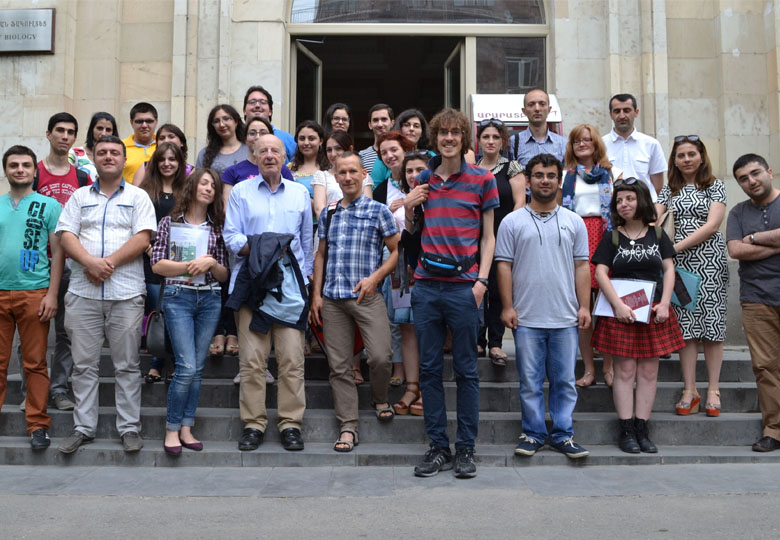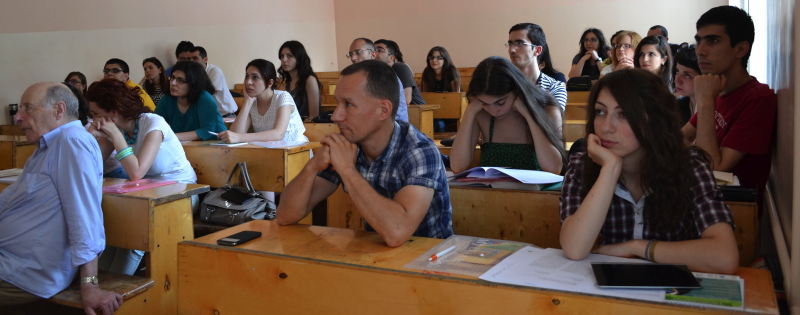By Helen Figueira
July 27, 2015
Time to read: 6 minutes
This year Armenia is remembering the tragedies it suffered 100 years ago at the time of the First World War. The country is trying to move on from its tumultuous past and build a stable economy. One of our scientists has ancestral roots in Armenia and was recently invited back to discuss his research with undergraduate students. He was touched by their stories about how difficult it is to be a young scientist in the country, and the inventive ways in which they are tackling adversity. In this personal account he describes some differences between life as a young scientist here in the UK and in Armenia.

Peter Sarkies
Think of Armenia and what comes to mind? If you have heard of it, you will most likely think of the tragic events that happened 100 years ago, and which cost the lives of an estimated 1.5 million Armenians. You might think of Mount Ararat, the iconic symbol of the nation, or the country’s unique cultural traditions forged at the interface between Eastern and Western civilizations.
One thing you will almost certainly not associate with Armenia is molecular biology. But Armenians, particularly those living outside of the country, called the diaspora, have been involved in many major breakthroughs in science and technology. One striking example is Raymond Damadian, who contributed to the invention of the first MRI scanner. Damadian was born in New York to Armenian parents, and narrowly missed out on the Nobel Prize for Physiology or Medicine in 2003 that went to Lauterbur and Mansfield. As a scientist and a member of the Armenian diaspora, I am keen to see my ancestral land develop its own scientific base. However, with an economy damaged by recent conflicts, closed borders, emigration and a decline in investment, funding for scientific research in Armenia has fallen dramatically since 1990. Young scientists now face great challenges in developing a career in research.
I recently gained a unique insight into these challenges when I delivered a lecture at Yerevan State University, in Armenia, as part of a course to help promote life sciences research in the country. The course was titled “Science through first hand accounts: Epigenetics”, and was organized by the Young Biologists Organization.
It is a law in Armenia that the government has to offer a permanent research position to every successful PhD graduate, but junior researchers receive only around €100 per month. This makes it is impossible to live on a research salary alone. Even supplementing the salary with heavy teaching loads is not enough, and many young scientists must take multiple jobs in order to make ends meet.
Sargis Aghayan, who is vice-president of the Young Biologists Organization, also works as a travel guide for an EcoTourism business that he founded. He tells me that he would prefer to concentrate on science but the business takes up the majority of his energy. Somehow he still finds the time to collect blood samples from birds across the country to study how the distribution of Avian Malaria in Armenia is being affected by climate change.
For many PhD students the situation is even more extreme. I met one student who works in a milk-packing factory at 6am every morning before coming to the lab in the afternoon.
Even if scientists can find a way to support themselves, funding for research is pitifully low. Most standard lab chemicals take several months to arrive and bottles of serum, particularly expensive to buy in Armenia, are made to last for as long as possible by growing cells in tiny volumes using minimal amounts.
Nevertheless, I was struck by the inventiveness and tenacity of Armenian scientists, such as Hovakim Zakarian, who is establishing his independent laboratory to investigate the pathology of African Swine Fever Virus (ASFV). His choice of pathogen is a shrewd one because ASFV is as an emerging problem. The virus has a 100% mortality rate amongst pigs so is a real threat to agriculture, but only 10 or so laboratories in the world are working on it. This gives Hovakim the space to make a name for himself.
Starting out in 2014, Hovakim was given a totally empty space, lacking even laboratory benches, and a grant of €5000 (£3500) to last for a year. Using a combination of crowd source funding from friends and colleagues, judicious purchases and kind donations of used lab equipment from abroad, Hovakim has kitted out his lab with some relatively modern equipment and has started to get some promising results. In fact, Hovakim and I are establishing a collaboration to investigate the role that small messenger molecules play in viral infections.
Hovakim’s resourcefulness shows it may be possible for Armenia to build a research base that takes advantage of its talented undergraduate and PhD students. The Young Biologists Organisation’s course aimed to inspire students, and expose them to the ways in which research is performed in other countries.

Over 100 students enjoyed lectures about the emerging field of epigenetics. The process of epigenetics involves changes to our DNA that can turn our genes ‘on’ or ‘off’, without altering the genes themsleves. During my talk I introduced the students to messenger molecules, called ‘small RNAs’, which may play an important role in epigenetics but which are not yet covered on their degree courses.
After the lectures, we all held discussions so that the students could network with young researchers like myself. The students in my group were initially quiet, but with encouragement soon contributed their own ideas and engaged with the challenging topic with great enthusiasm.
I left Armenia profoundly affected by the experience. The passion of the young scientists despite obstacles inspired me to make the most of my own science and left me hopeful about the future of scientific endeavour in Armenia.
Peter Sarkies leads the Transgenerational Epigenetic Inheritance and Evolution research group at the MRC’s Clinical Sciences Centre, based at Imperial College, in West London. Find out more about his research.
For further information, contact:
Deborah Oakley
Science Communications Officer
MRC Clinical Sciences Centre
Du Cane Road
London W12 0NN
T: 0208 383 3791
M: 07711 016942
E: